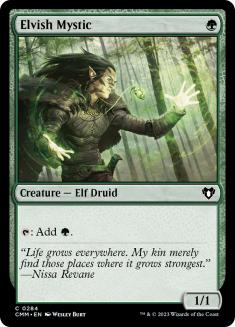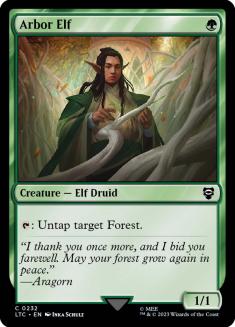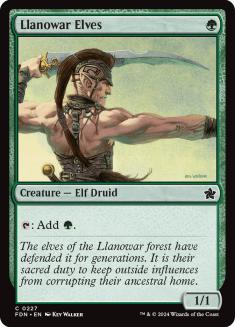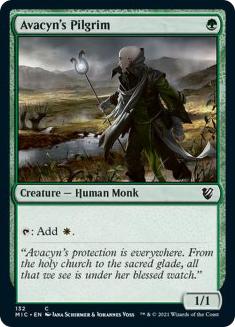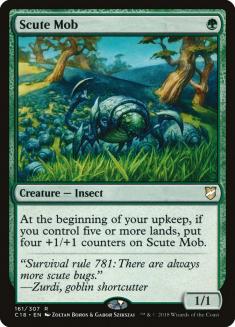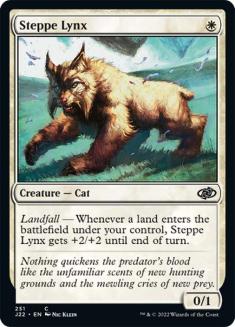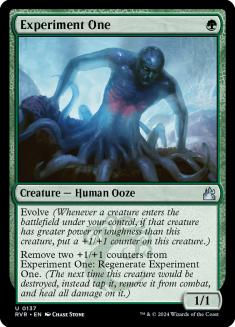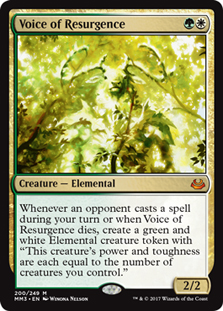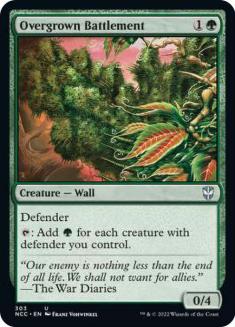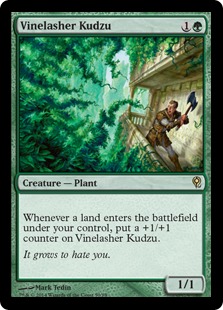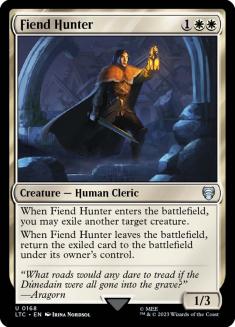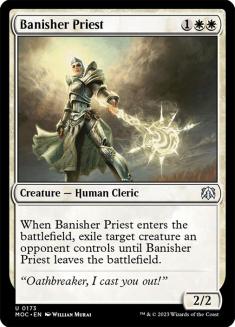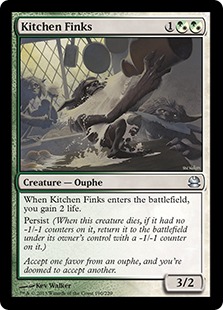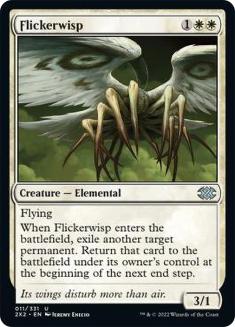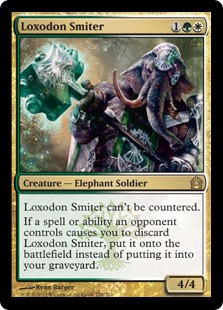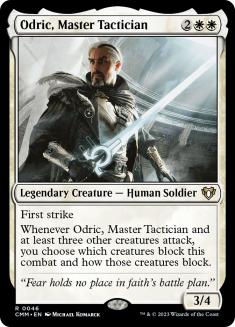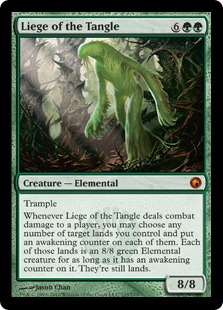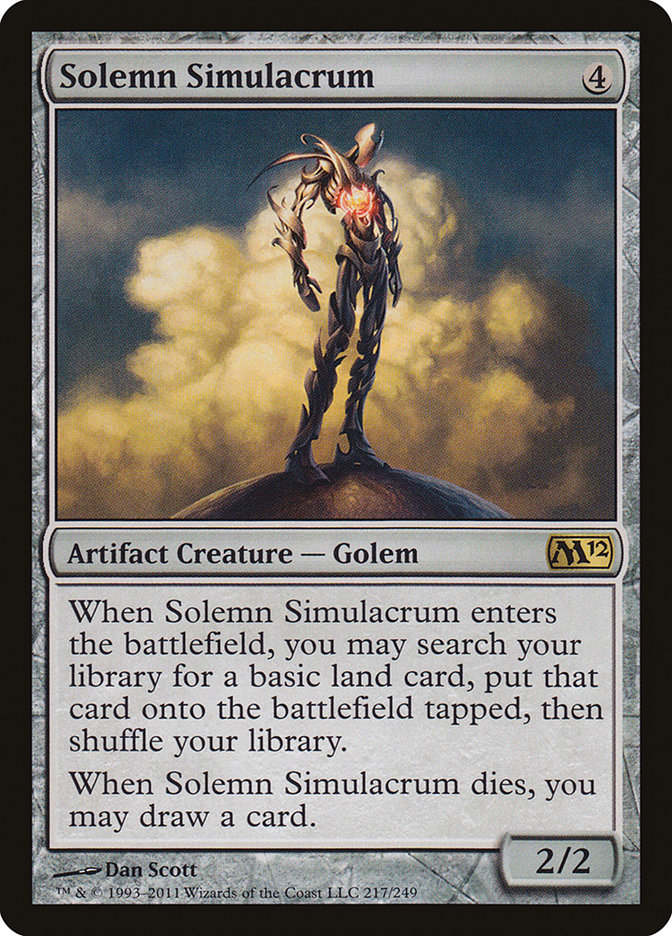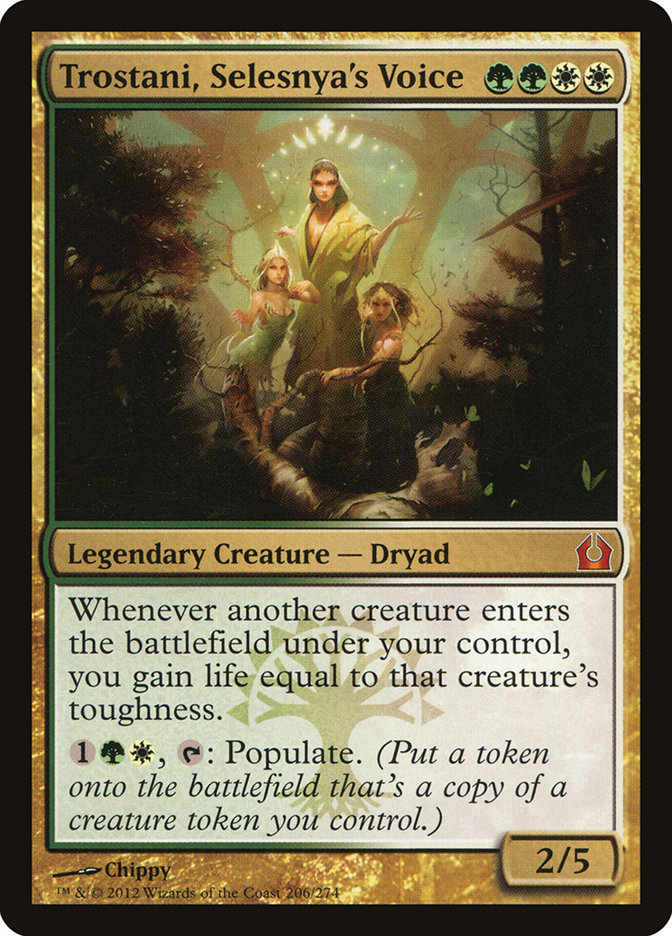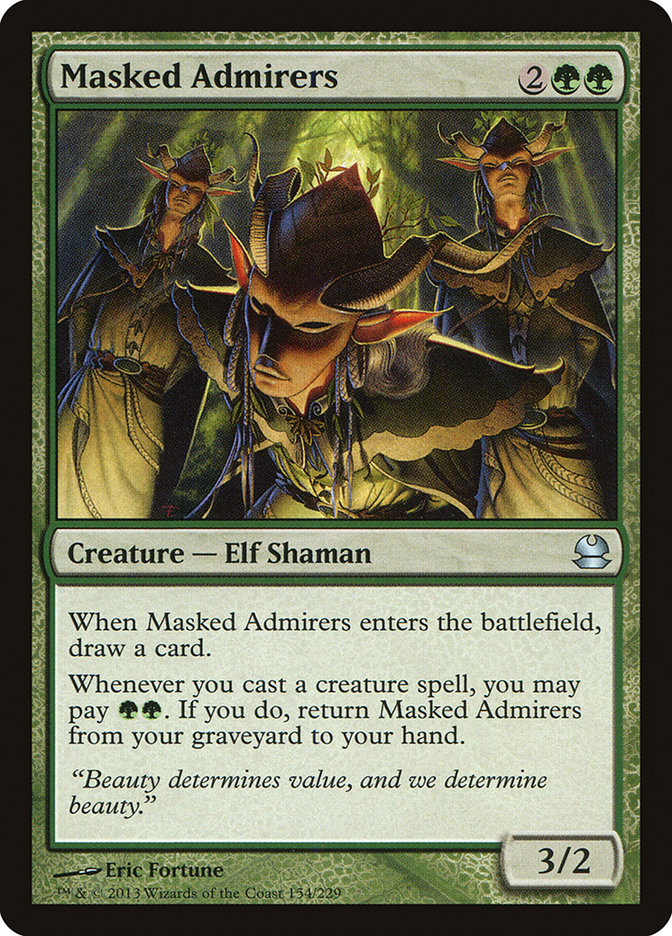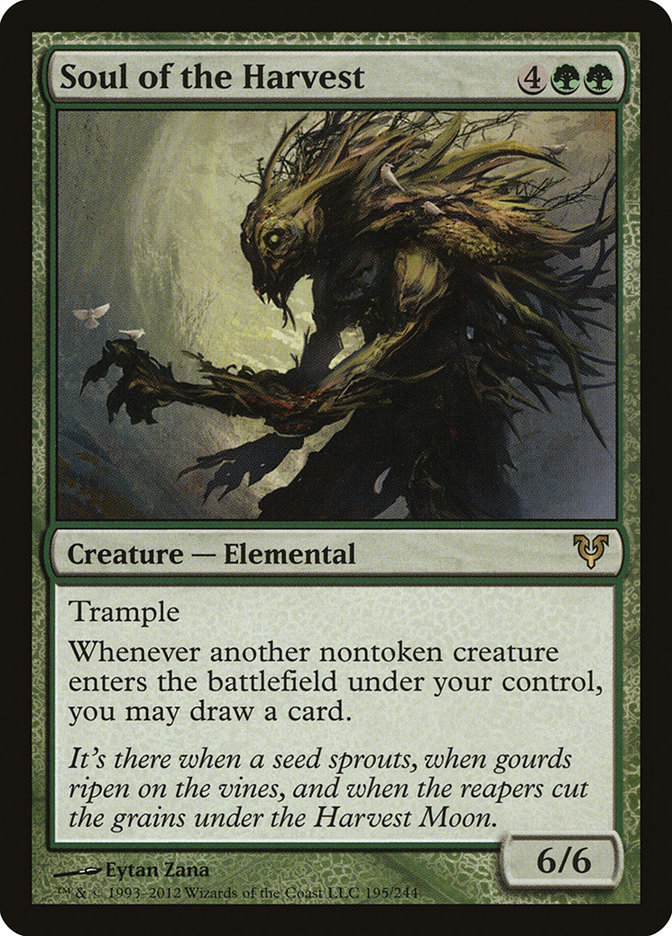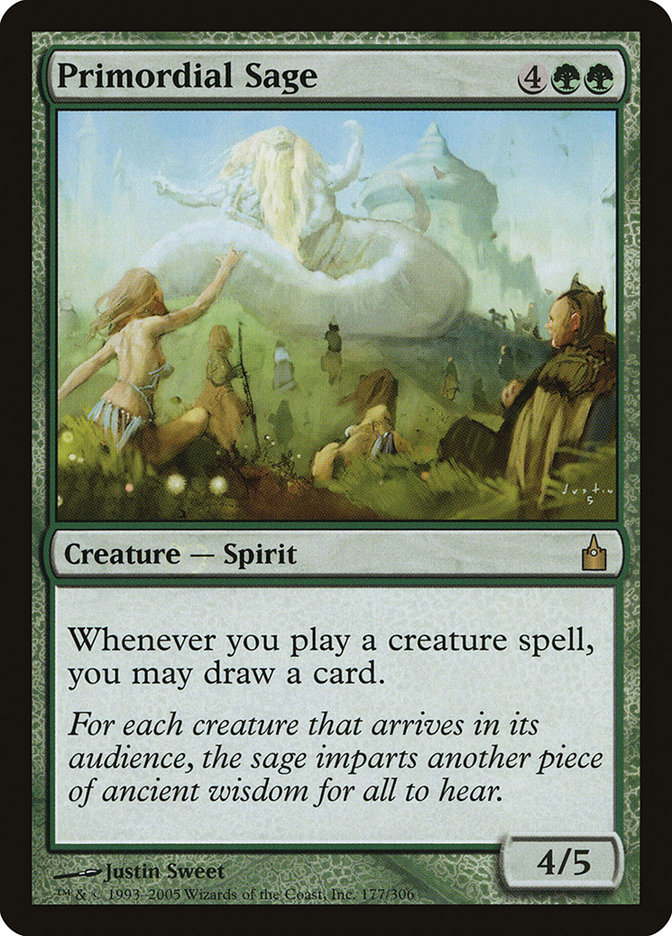|
Dear Azami, Since then, I have traded around for better cards for the deck and I’ve ended up with something I am proud of and love to play, but which I always feel The deck started out as Karametra with as many landfall cards I could find and big creatures I could ramp into, but has since gained a plethora of weenies Anyway, here’s what I have so far: Commander: Karametra, God of Harvests Creatures: Instants and Sorceries: Enchantments: Artifacts: Lands: I hope you enjoy this deck, and I hope I can continue to prove the naysayers wrong about the God of Harvests. – Alex |
Anyone who’s making fun of Karametra as a commander option needs to re-read that card – sure, maybe it’s not that great as a creature, but the
cycle of Gods lets you play some pretty amazing enchantments as your Commanders. Maybe you won’t be attacking with Karametra that often, but if the
enchantment is powerful – and your build is focused on making sure that is true – you should be the one getting the last laugh here.
Speaking of playing weird card types as your Commanders, there was some fascinating previews at San Diego Comic-Con this past weekend… not just the name
of the five “wedges” that we’ll be playing with as Khans of Tarkir is in fact the enemy-colored version of Shards of Alara Block, there was also an
intriguing Commander spoiler that is sure to break brains:
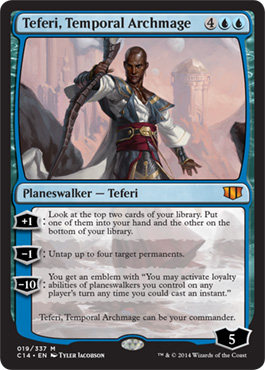
Check that last line of text, it’s easy to miss.
Teferi was spoiled as part of this year’s Commander 2014 release – suggesting that there will be (at least) one Planeswalker playable as your Commander for each of the five colors. And if they’re all as brain-bending as this one, it’s going to be a weird release – a
Planeswalker who grants you an emblem to use planeswalker abilities on other players’ turns is going to be all sorts of temporally confusing, which of
course is what Teferi is all about in the first place. Other card types functioning as Commanders is actually quite powerful, so Karametra need not ever
beat down in order to deserve due respect.
Most of what we’re needing to focus on here is deck balance; your concept and overarching “theme” sounds like a strong fit for Karametra and the kind of
thing that can build up into a strong board position, but you’re finding yourself running out of action before you run out of opponents. That says to me
that you’re not getting enough out of your cheap drops – you want them to generate Karametra triggers, sure, but they have to do something
themselves – and since most of yours are dedicated solely towards making mana, you’re just doubling up on something you’re planning to have plenty of
anyway by the end of this adventure, so they don’t really have useful text. Your lower-cost cards are the part that is off balance, though if you could get
some extra card draw off of your top end that would probably be a good thing for you too.
This means that we’re going to go away from the sort-of aggro part of the deck with Steppe Lynx and Experiment One, moving towards a bit of a bigger build
– not really “midrange,” just a bigger flavor of aggro deck, planning to do a bit of setup in the earlier turns so that you can cast Karametra early, do
your trick with the Landfall triggers and ramping into fatties, then refill your hand so that you can keep going. A lot of the cards I’m going to add will
try to hit several of these notes at the same time, if possible, and we’re going to upgrade your removal package as well – we’re not going to expect to be
getting that early step ahead of the opponent that the cheap drops were trying to enable, and that means we’re going to have to be able to remove cards
from play a bit more effectively.
Let’s get to work, shall we?
Mana Makes The World Go Round
You want to have a lot of basics for Karametra, but we can get some utility out of your manabase while still keeping things pretty cheap. I’d favor a few
more dual lands, actually, but since you’re only a two-color deck that’s not as important to us here and most of that value can be gotten as we
improve the mana-fixing abilities of the rest of the deck. Getting more value out of your lands, though, isn’t something we can work on elsewhere – so
we’re going to make a few cuts here in order to make the deck’s manabase a little more spell-like.
OUT:
4 Forest, 3 Plains, Dryad Arbor
IN:
Winding Canyons – I am super-big on this card, just in general, to the point where it’s a running gag in the forum for several years now. But the best way
to dodge Wrath effects and other people messing with your stuff is to move off of sorcery-speed Magic and start playing your creatures as instants. While
this doesn’t really let you store all those potential Landfall triggers for attacking with creatures, you can take advantage of them to build up
your mana at end of turn and then untap for a really big turn before anyone really gets a chance to stop you.
Dust Bowl – Utility lands won’t really be a problem here… sure, Maze of Ith stops one big threat, but you’re building such that you’ll be able to attack
with multiple big creatures at the same time. However, opponents who are getting super-far ahead of you with Cabal Coffers or something similar will be problematic, and you can take advantage of the fact that Karametra gets you free lands by putting them to work turn after turn on bomb
patrol.
Temple Garden – When it comes to fixing your mana, counting as both basic land types means that we can potentially find this instead of a basic with some
of the manafixing.
Mosswort Bridge – One of the best ways to get paid back for doing what you’re doing is to get a free spell out of your manabase. Green’s hideaway land is
the best since it is the easiest to trigger cheaply and at any given time, so at the least we’ll want to add this one as part of our overarching plan to
get paid back and still have action after that One Big Turn your deck builds around.
Kor Haven, Mystifying Maze – Your build is very aggressively-focused, and while I don’t necessarily want to add a lot of defensive spells to the
deck, we can get a lot of extra value when adding defensive options as part of your manabase. Just having the option sitting on the table will force people
to look elsewhere in order to use their combat forces more effectively, so you don’t even need to have that active of a defense for them to do good work.
The other two slots we’ll be using elsewhere – you don’t need to play more than the 38 or so lands that are in your average Commander deck when you’re able
to use your Commander to ramp so effectively.
The Spell’s The Thing
Your deck is very creature-heavy, a natural result of optimizing Karametra – you want to have several creatures you can play right after you deploy your
Commander, and that means you just want to play a whole lot of creatures in general. The specifics get a little more complicated than that, but the desire
to regularly draw a good balance of creatures is clearly here and the balance is overall largely correct as far as the deck’s mana curve is concerned. We
do want some more spells, though, and we’re going to end up cutting two creature slots as well as using those two slots from the land base while we’re at
it.
This is going to be the big place where we get to add more card drawing to the deck; we’ll be able to add some in the creature section, sure, but the big
bunches of card-draw that you may be capable of will all come from the additions we make here.
OUT:
Summer Bloom, Tempt With Discovery
We are going to ramp, it’s true, but neither of these are on the agenda. Summer Bloom requires you to have drawn enough lands to make using it worthwhile,
which is speculative at best in a deck that plays an otherwise ‘normal’ balance of lands. And Tempt with Discovery is aiming for the same end-point
Karametra is intended to get us to… and gets us there presumably by helping the opponent out, potentially dangerously so since it is not limited to
getting just basic lands. The very problems that Dust Bowl was intended to solve, this card will exacerbate… and while in the abstract it’s more powerful
than I’m giving it credit for, in the context of your deck the ability to put a couple extra lands into play isn’t worth the downside of helping your
opponents out.
OUT:
Terra Eternal, Rest In Peace
You didn’t give me any context to suggest that your metagame requires you to play Rest In Peace, and otherwise you’re not really playing many cards to hose
recursion strategies or tutor for it, so I’m not inclined to think it is very important as far as disrupting the opponent’s plans goes. Terra
Eternal is important for protecting you from a problem that, in general, people abstain from posing – it could be more relevant if there were ways for your
lands to become creatures, but the only way I saw to do that ended up on the cutting-room floor, so I don’t see much need for keeping this around.
OUT:
Spine of Ish Sah, Oblivion Ring
I don’t like solution cards that my opponent can just undo to get the problem back, and I don’t like spending seven mana for sorcery-speed removal either.
Spine is excellent in a deck that can reuse it, which we are nowhere near, and pretty crummy otherwise.
OUT:
Amulet of Vigor, Collective Blessing
Our creatures are going to be dangerous enough already without needing to play an enchantment to boost them, though the size benefit is pretty
close to tempting me – however I’m more likely to want something like True Conviction in its stead, as it would likely offer the same amount of bonus
damage if not more, plus add the side benefits of lifelink that might win a race sometimes. “Just” a size bonus doesn’t quite do it, though. As to the
Amulet – yes, it lets the lands you put into play from Karametra come into play untapped, but that doesn’t actually seem like enough of an incentive to
actually play it. Playing enablers like these just helps get to the point where our hand is empty and we’re left hoping that the top of the deck is good,
it’s better to have another real card instead of try and deploy the rest of them faster. I’d rather build to refresh my hand than to try and really maximize the amount of stuff we can do in a single turn, because I’d like to be able to have multiple big turns in a row if possible even
if that means each turn is not quite as big as might otherwise be achieved.
IN:
Erratic Portal – We’re going to have plenty of creatures with enters-the-battlefield abilities for us to work with, and Erratic Portal gives us the ability
to reuse whichever one we want turn after turn. It also happens to just save creatures from removal, too, if it’s a heavy hitter that needs saving instead
of a utility creature. Heck, even if we were just buying back a Grizzly Bear to recast, that’s a free land off of Karametra – we want to ride the value
train, and Erratic Portal will help make sure we have cards to work with.
Horn of Greed – Symmetrical cards that seem like they “hug” people are dangerous, and everyone knows it. However, based on your design you’re going to be far more able to use this profitably than your opponents will be – since Karametra adds “find a land” to each of your creature spells, this turns
it into “find a land, draw a card” and will help ensure that you can play action by replenishing your hand over the course of several large turns, making
you considerably more dangerous than you would otherwise be.
There is the risk that this card is just on the other side of “too good,” that it will push into broken and un-fun places if you draw it early
enough in the game to be relevant. It is, however, just one card out of 99 – you shouldn’t draw it often enough for it to be a real problem, since you have
no way to tutor for it and thus make its appearance regular enough to really tick people off. In a deck that could find it consistently, this would be an
over-the-top addition on the other side of the line of what I consider “fair game” in Commander, but a high-powered addition that will appear only by the
chance of the draw is fine in moderation.
Beast Within, Oblation – I think being able to handle any permanent is important, but I’d rather do it at instant speed and as affordably as possible,
which lets us replace Spine and O-Ring with these two and not worry too much about the ‘drawbacks.’ I find I Oblation my own permanents almost as often as
I target an opponent’s, just to draw the cards or protect an important resource from being exiled, and an opposing 3/3 shouldn’t really be a big problem
either.
Austere Command – You otherwise lack sweepers, but I thought this would prove flexible enough for you to always have a beneficial mode – you’re light on
both enchantments and artifacts, two of the more important modes this is usually played for, and it’s important to at least potentially have an out if you
get very far behind the opponents. After all, you can’t always rely on other peoples’ Wrath effects to bail you out of a problem just because they’re
caught up in it the same as you are. If everyone applied that strategy, everyone would just get overrun.
Explore, Kodama’s Reach, Cultivate – I don’t want that much early game acceleration for your deck, and the ones you do play, I want them to either
draw you a card (hi Explore!) or make sure by themselves that you will get from three mana to five mana in order to cast Karametra. I only think Summer
Bloom is better than Explore when you actually have three lands to play out that turn, and that’s so unlikely in this build that I’m rounding the chances
of it happening down to zero. And as for the other two, sure, they’re less powerful in the abstract than Tempting Offers might be, but they also cost a
mana less and let you play Karametra a full turn earlier, something your four-drop ramp spell is unlikely to accomplish.
Eladamri’s Call – If you’re green and white and you like creatures, this card is perfect for you. It’s easy to overlook and forget about – I’m pretty sure
I forgot it even existed for about a year somewhere in here – but it’s just Demonic Tutor for the creature spell of your choice, as simple as that. All in
all, a pretty good deal for a color combination that doesn’t get a lot of tutoring at a reasonable price.
Life’s Legacy; Momentous Fall; Garruk, Primal Hunter – I like big draw spells and I cannot lie. Sure, sacrificing a creature that you’ve just put all of
this work into ramping out can feel like a bummer, but this deck is not actually lacking for heavy hitters and drawing off of your best monster is a strong
way to replenish your resources. Garruk, Primal Hunter sacrifices himself instead of the creature – or at least he does if you play him as a sorcery rather
than try to set him up as a Beast-generating machine – but that still feels a little bad compared to how much potential the card seems to have if you read
all of the abilities and get attached to them. Here we’re basically just using it for “-3” and anything pat that is gravy, since we’re not really building
the deck to defend a planeswalker well.
Drawing cards lets us have stuff left over when our one big turn is over so we can dust ourselves off after a sweeper and try it again… or just have an
even bigger turn on our next turn!
And with that sorted out, we are going to have to make two cuts from the creature base in order to slim back down to 99. If possible, we’d like to still
improve our card-drawing potential and leave our mana ramp effects less exposed to sweeper spells if possible. This isn’t Standard or even Modern, we can’t
play one-drop mana creatures and just try to fade the sweeper spells – with three opponents that is basically choosing to ignore reality when it is clearly
presented to you. We can still accelerate the way we want to, but I’m aiming to build in such a way that when, not if, the Wrath happens, we’ll be
able to pick ourselves up and move on immediately rather than spend a turn or two having to rebuild our mana before we can even start to rebuild our board.
Let The Bodies Hit The Floor
Here’s where we get brutal and start cutting things left and right. You had just over forty creatures to begin with, and we’re going to slice nearly half
of them out of the deck before we fill them back in with cards that look similar and fill the same role but come with an upgrade in some capacity. 18/42
are just getting cut, two of them just in order to make room and the other sixteen to find a better-fitting cousin – we are going to shift the mana curve
just a little bit northward, but not really by a lot, mostly because one-drops are generally going to be poor additions to your Commander deck
even when they seem like they could do a lot of heavy lifting. We’re going to focus more on the two- and three-drops, then shift focus so that we always
have a heavy hitter when we want one and can take advantage of Karametra by playing awesome fat on demand.
Almost all of the cutting happens at the low end of the curve, because beating down in Commander is much more about building pressure and sustaining it
than it is about getting that first leap onto the board with a 1/1 or 2/2 at the start of the game. We’re going to build around the stages of the game you
identified as important to you instead – first we ramp to cast Karametra early if possible, then we Do Stuff And Get Lands, then our opponents
should really be under pressure and on the clock. Here’s what I see filling in for these cards, even acknowledging that for the most part their roles were
important to us:
1cc:
Joraga Treespeaker, Diligent Farmhand
It takes a lot to get me interested in a one-drop mana creature, though admittedly “Animar is my Commander” counts as “a lot” (historically speaking) so I
shouldn’t be so critical here. That you want to accelerate into your Commander is key, but how you do it matters a lot too – and Diligent Farmhand is a
one-drop that basically pretends to be a Sakura-Tribe Elder, putting a basic land into play that we can expect to have hang around no matter how many Wrath
effects our opponents may play. Joraga Treespeaker gets the nod here because it is just too powerful not to, when considering cards more-or-less
in a vacuum: drawing Treespeaker and no other acceleration will let you play Karametra on turn three all by itself, which makes it comparable to only Sol
Ring as far as power acceleration effects are concerned.
2cc:

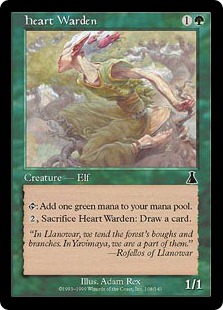
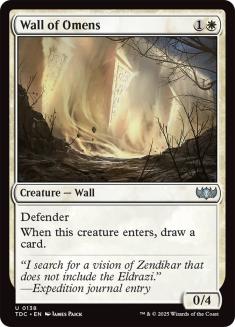
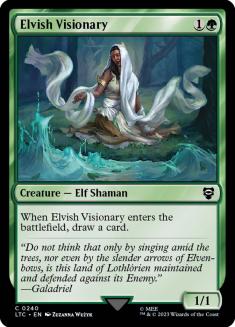
Magus of the Library doesn’t even tap for colored mana, but the fact that it has a second tap ability – the Library of which it is a Magus is the (banned)
Library of Alexandria – means we’ll be happy to include it among our ramp creatures… in the later stages of the game it will still be useful,
potentially able to tap for an extra card every turn when we have enough mana and would rather find more things to do with it. Heart Warden is a
low-power Elf, it’s true, but unlike the one-drops it can potentially cash itself in for another card – we’re worrying about running out of stuff worth
doing once we have enough mana to work with, and being able to cycle from play makes it more worthwhile than a comparable one-drop Elf to me. If price were no object, we’d be discussing Rofellos, Llanowar Emissary here as well, but as your deck looks to be on a pretty low-key budget and
Rofellos is up to $30 or so these days, I won’t be suggesting it unless you already own a copy and can play it without having to sink anything into
obtaining it.
Our last two additions are here because they let you replace themselves immediately, the same as Wall of Blossoms does, letting you add to the board with
Karametra out and get the ramp trigger but still have a card in hand to show for it. There is another creature we could add that shares that trait,
Multani’s Acolyte, but between the double-colored mana and having to pay echo if you want to do anything with it, I ended up with it as card #100 in your
99-card deck, the last thing cut that I would have liked to be able to add (… potentially because, like Heart Warden, it’s not a card that fits
a whole lot of decks, you know?).
3cc:
Carven Caryatid – Cantrip-critter Walls are fine as far as this deck is concerned; we aren’t that interested in having a blocker, it’s true, but
we want to get a lot of Karametra triggers and still have gas left over for later, so playing Walls and drawing cards is a great way to cast cantrip
Rampant Growths.
Wood Elves – Speaking of Rampant Growths, I liked your Farhaven Elf so much I added its better cousin, Wood Elves. Sure, Farhaven Elf can get a Plains and
thus fix your mana instead of just getting a stupid old Forest… but Temple Garden says both Forest and Plains, so Wood Elves can get you that Forest and
your white mana too. Since the land comes into play untapped it’s going to be much better after casting Karametra, and I’d rather play a slightly slower
card that put a land into play for later use than a flimsy creature that we’re expecting to be able to tap for mana unmolested later on anyway – that never works out as well as we might hope it would, mass removal is far too plentiful in this format.
Yavimaya Elder – This isn’t “acceleration,” per se, so it will never cast Karametra faster – but like Kodama’s Reach and Cultivate, this by itself
helps make sure that we can get from three mana to five mana in order to cast our Commander, since land drops #4 and #5 are both included with this
particular piece of cardboard. Burnished Hart is potentially better since it puts the lands directly into play rather than putting it in your hand, but
later on in the game you’ll be glad for the fact that Elder draws you a new card when you use it to get these resources and probably won’t care whether you
have to play the lands from your hand. This is more like a part of the card-advantage side of the deck than the ramp side, but it’s so powerful it starts
to blur the lines and has been an awesome addition to any green deck for as long as the format has existed.
4cc:
Once we’re getting into the four-mana range, things are starting to get a little expensive for playing after Karametra and are no longer helping us speed
up Karametra by a turn anymore, as the turn we should be accelerating to cast our Commander on is the turn we’re probably casting them. Oops. That
said, we like cards a lot, and want to be able to consistently generate resources – Masked Admirers is a steady flow of cards turn after turn assuming
we’re able to play our normal game the way we want to, while Solemn Simulacrum is just a good, reliable two-for-one that will serve us well. Trostani is
actually the odd duck here – no card draw, no ramp, and we basically can’t use the Populate ability either so there’s even less text than there appears to
be. However, that said, Trostani provides an awful lot of two different resources we may be valuing: devotion, and life.
The Devotion shouldn’t really pull us in, because we’re not really focusing on Karametra attacking anyway – sure, it’ll happen sometimes, but it’s
not like we’re building for it, that’ll be far more of a rich-get-richer kind of occurrence where we’re so far ahead on the board that it doesn’t matter.
The life, well, I usually hate – it’s true – but I’m willing to bend my too-stiff neck when it comes to a very good deal on this resource I generally
undervalue. And a good deal is what Trostani offers – more and more life as you go higher and higher up the curve, with no mana investment ever asked for
no matter how much life you get. It’s like all of your creatures are suddenly Pelakka Wurms here – and an actual Pelakka Wurm just becomes an insane joke,
pelakka pelakka wakka.
5cc:
We’re actually skipping this one here. You’re pretty sparse on it yourself, since this is the turn you’re planning on casting Karametra; it makes plenty of
sense that you’d want to play either bigger or smaller pieces of cardboard.
6cc:
Your plan for that One Big Turn can now go even bigger. We aren’t ever going to “go broken” with these – there’s no draw-your-deck combo that lets us do
something obnoxious with these two, which are both effectively copies of Glimpse of Nature strapped to a sizable body. Like Horn of Greed, these upgrade
all of your creatures from “+Rampant Growth” to “+Rampant Growth, +cantrip,” but unlike the Horn these cards don’t share – and they also don’t require
Karametra to resolve and/or stay in play to reap these benefits, allowing you to have some potential backup plan if your Commander gets removed somehow.
These are going to have huge red bulls-eye’s on them so I wouldn’t really expect to be able to get away with too much off of them, but both of
them potentially allow you to play a whole bunch of cards to the board and not end up empty-handed as you’ve noted is your most frequent problem – anything
that does that is okay in my book.
7cc:
Garruk’s Horde – Playing cards off of the top of your library is already something you’re ready to do thanks to Oracle of Mul Daya and Courser of Kruphix,
and while you aren’t really able to manipulate the top card of your deck, just getting some extra freebies sometimes is already a decent deal.
Anything that can potentially clock the opponent and keep the fun parade marching along is going to do a lot more work in your deck than it would
in a comparable green build, thanks solely to the fact that Karametra provides so much free mana over the course of a game, so we can expect this to do
good work even if most people simply overlook it these days now that it isn’t shiny and new anymore.
Novablast Wurm – It’s true that this can take down your fatties, your mana ramp creatures, and all of those other setup cards you’ve put into play before
trying to rely on a heavy hitter to close the game out. However, it decimates everyone else’s board too – turn after turn, attack phase after attack phase.
It’s another one of those cards that sees play infrequently despite being awesome and thus tends to slip from memory, but this dominates the board in a way
your color combination doesn’t usually see and has the most-fun variant of “unblockability” we have ever discovered. And if you happen to have Avacyn or
even just an indestructible commander, something interesting might happen… and to give you an idea of how amazingly ridiculous of a deal this is, I keep
convincing myself that Novablast Wurm costs either nine or twelve mana for no particularly good reason, only to look at it again and find it is a downright
absurd seven mana to dominate the board with.
Putting it all together, we get the following:
Creatures (40)
- 1 Sakura-Tribe Elder
- 1 Solemn Simulacrum
- 1 Wall of Blossoms
- 1 Wood Elves
- 1 Eternal Witness
- 1 Yavimaya Elder
- 1 Heart Warden
- 1 Diligent Farmhand
- 1 Carven Caryatid
- 1 Primordial Sage
- 1 Magus of the Library
- 1 Masked Admirers
- 1 Farhaven Elf
- 1 Elvish Visionary
- 1 Acidic Slime
- 1 Baloth Woodcrasher
- 1 Grazing Gladehart
- 1 Iona, Shield of Emeria
- 1 Lotus Cobra
- 1 Oracle of Mul Daya
- 1 Rampaging Baloths
- 1 Admonition Angel
- 1 Avenger of Zendikar
- 1 Novablast Wurm
- 1 Joraga Treespeaker
- 1 Pelakka Wurm
- 1 Wall of Omens
- 1 Garruk's Packleader
- 1 Elesh Norn, Grand Cenobite
- 1 Garruk's Horde
- 1 Avacyn, Angel of Hope
- 1 Champion of Lambholt
- 1 Soul of the Harvest
- 1 Trostani, Selesnya's Voice
- 1 Angel of Serenity
- 1 Angelic Skirmisher
- 1 Archangel of Thune
- 1 Sporemound
- 1 Burnished Hart
- 1 Courser of Kruphix
Planeswalkers (1)
Lands (38)
Spells (20)
- 1 Horn of Greed
- 1 Swords to Plowshares
- 1 Sol Ring
- 1 Kodama's Reach
- 1 Tower of Fortunes
- 1 Oblation
- 1 Erratic Portal
- 1 Eladamri's Call
- 1 Harmonize
- 1 Austere Command
- 1 Path to Exile
- 1 Behemoth Sledge
- 1 Explore
- 1 Seer's Sundial
- 1 Momentous Fall
- 1 Cultivate
- 1 Beast Within
- 1 Druidic Satchel
- 1 Primeval Bounty
- 1 Life's Legacy

As always, for your participation in this week’s edition of Dear Azami you will receive a $20 coupon to the StarCityGames.com Store, which should
go a good chunk of the way towards letting you fill out a bunch of these slots now that we’ve torn your deck apart and rebuilt it all over again. While
there are a few expensive additions – nine of our suggestions cost $5 or more, and the most expensive is the now-$12 Winding Canyons that used to be $3
when I started advocating for it back at the start of this column – with 34 suggestions we’ve hit just under $100 to rebuild the deck, and the median price
is just $1.49 – you could probably make half of the cheaper swaps just with that $20 coupon because we’ve tried to stay on a pretty reasonable budget. (An
unreasonable budget would involve a Gaea’s Cradle, fetchlands to help trigger Landfall more, and a Savannah – but we’re keeping it reasonable here.)
Pricing them out individually, those additions look like this:
| Card: | Price: |
| Diligent Farmhand | 0.25 |
| Heart Warden | 0.25 |
| Masked Admirers | 0.25 |
| Carven Caryatid | 0.49 |
| Elvish Visionary | 0.49 |
| Garruk’s Horde | 0.49 |
| Magus of the Library | 0.49 |
| Wood Elves | 0.49 |
| Yavimaya Elder | 0.75 |
| Cultivate | 0.99 |
| Explore | 0.99 |
| Kodama’s Reach | 0.99 |
| Life’s Legacy | 0.99 |
| Momentous Fall | 0.99 |
| Mystifying Maze | 0.99 |
| Soul of the Harvest | 0.99 |
| Mosswort Bridge | 1.49 |
| Oblation | 1.49 |
| Primordial Sage | 1.49 |
| Beast Within | 1.99 |
| Joraga Treespeaker | 1.99 |
| Novablast Wurm | 1.99 |
| Trostani, Selesnya’s Voice | 1.99 |
| Wall of Omens | 2.49 |
| Erratic Portal | 2.99 |
| Horn of Greed | 4.99 |
| Solemn Simulacrum | 4.99 |
| Garruk, Primal Hunter | 5.99 |
| Austere Command | 6.99 |
| Dust Bowl | 7.99 |
| Kor Haven | 7.99 |
| Eladamri’s Call | 9.99 |
| Temple Garden | 9.99 |
| Winding Canyons | 11.99 |
Hopefully this will work a bit better for you; the general concept of the deck is solid and your plan remains intact, we’ve just changed around the support
cards and enablers that were supposed to optimize it in order to build a more resilient, and more powerful, version of the deck. I think Karametra deserves
some attention as one of the better Gods to build your deck around – sure, it’s no Mirari’s Wake, but the amount of mana Karametra will allow you to build
up will be surprisingly comparable after a turn or two, and that doubling of your mana supply should be fairly permanent since it’s based on basic lands
rather than a permanent your opponent can likely remove from play.
Want to submit a deck for consideration to Dear Azami? We’re always accepting deck submissions to consider for use in a future article, like Alex’s Rosheen Meanderer deck or John’s Xira Arien deck. Only one deck submission will be chosen per article, but being selected for the next edition of Dear Azami includes not just deck advice but also a $20 coupon to StarCityGames.com!
Email us a deck submission using this link here!
Like what you’ve seen? Feel free to explore more of Dear Azami here, in the Article Archives! Feel free to follow Sean on Facebook… sometimes there are extra surprises and bonus content to be found over on his Facebook Fan Page, as well as previews of the next week’s column at the end of the week!

